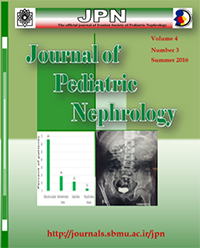The Prevalence of Shiga toxin-producing Escherichia coli in Patients with Gastroenteritis and Sources of Infections in Iran: A Systematic Review Study Protocol
Journal of Pediatric Nephrology,
Vol. 4 No. 3 (2016),
22 December 2016,
Page 82-85
https://doi.org/10.22037/jpn.v4i3.13315
Hemolytic Uremic Syndrome (HUS) is a leading cause of acute kidney injury in infants and children. The majority of HUS in children is secondary to Shiga toxin induced Escherichia Coli (STEC). Many countries have a strategy to identify the source of infection and annually estimate the rate of this infection but there is no prevention strategy to identify this infection in Iran.
The aim of this study is to find the percentage of STEC identified in various samples, in addition to find the outcome of STEC infected patients in Iran.
We will search PubMed, EMBASE, Google Scholar, Google, OVID, SCOPUS, Web of Sciences, IranMedex, MagIran, and SID, dociran, PDFiran, ganj.irandoc, and all online university database for thesis, and abstract books of regional or international congresses between January 1985 and January 2016.
One author will do the search screen for potentially eligible studies and two authors independently assess whether the studies meet the inclusion criteria. Discrepancies between the two authors will be resolved through discussion and arbitration by a third author. Data from the selected studies shall be extracted using a data collection form. The methodological quality of studies will be assessed using the STORBE checklist and risk of bias assessment tool developed by Hoy et al for assessing risk of bias for epidemiological studies. We will use random effects models to assess inter-study heterogeneity. Dichotomous data will be analyzed using relative risk and continuous will be assessed with data mean differences, both with 95% CIs.
Keywords: Gastroenteritis; Humans; Iran; Prevalence; shiga Yoxin 2; shiga-Toxigenic Escherichia coli.

